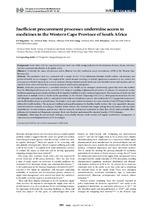Inefficient procurement processes undermine access to medicines in the Western Cape Province of South Africa
Date
2017Author
Magadzire, Bvudzai Priscilla
Ward, Kim
Leng, H.M.J.
Sanders, David
Metadata
Show full item recordAbstract
BACKGROUND. South Africa (SA) has experienced several stock-outs of life-saving medicines for the treatment of major chronic infectious
and non-communicable diseases in the public sector.
OBJECTIVE. To identify the causes of stock-outs and to illustrate how they undermine access to medicines (ATM) in the Western Cape
Province, SA.
METHODS. This qualitative study was conducted with a sample of over 70 key informants (frontline health workers, sub-structure and
provincial health service managers). We employed the critical incident technique to identify significant occurrences in our context, the
consequences of which impacted on access to medicines during a defined period. Stock-outs were identified as one such incident, and we
explored when, where and why they occurred, in order to inform policy and practice.
RESULTS. Medicines procurement is a centralised function in SA. Health service managers unanimously agreed that stock-outs resulted
from the following inefficiencies at the central level: (i) delays in awarding of pharmaceutical tenders; (ii) absence of contracts for certain
medicines appearing on provincial code lists; and (iii) suppliers’ inability to satisfy contractual agreements. The recurrence of stock-outs had
implications at multiple levels: (i) health facility operations; (ii) the Chronic Dispensing Unit (CDU), which prepacks medicines for over
300 000 public sector patients; and (iii) community-based medicines distribution systems, which deliver the CDU’s prepacked medicines to
non-health facilities nearer to patient homes. For instance, stock-outs resulted in omission of certain medicines from CDU parcels that were
delivered to health facilities. This increased workload and caused frustration for frontline health workers who were expected to dispense
omitted medicines manually. According to frontline health workers, this translated into longer waiting times for patients and associated
dissatisfaction. In some instances, patients were asked to return for undispensed medication at a later date, which could potentially affect
adherence to treatment and therapeutic outcomes. Stock-outs therefore undermined the intended benefits of ATM strategies.
Conclusion. Addressing the procurement challenges, most notably timeous tender awards and supplier performance management, is
critical for successful implementation of ATM strategies.

